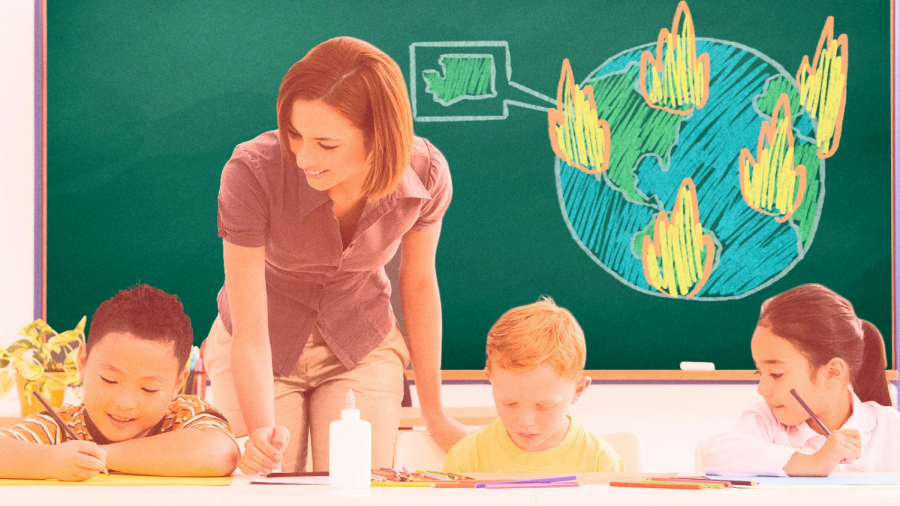The Crossroads of Crises
February 10, 2021
Mrs. Barenfeld, a chemistry and biology teacher here at Hastings High School, vividly remembers one of the most difficult parts of teaching in Los Angeles, California.
“The students were in portable classrooms for some of their classes with limited air conditioning,” she said. “They [were] paying attention to how hot it [was] and how much they need[ed] water.” The students sweated and the heat even got so bad that some of them put their heads down and closed their eyes.
Students who know what Mrs. Barenfeld is describing understand that high temperatures in the classroom are not only bothersome, but cease their ability to learn. Yet the scope of this goes well beyond Mrs. Barenfeld’s class in California as the impact of increased temperatures on classrooms is becoming an international issue, affecting students across the globe.
In a study published in Human Nature Behavior, the researchers concluded that students’ results on standardized tests worsen in correlation to hotter temperatures. In particular, the grades on these tests continue to drop for each day where the students experience temperatures of 80°F or more. To ensure the validity of these results, the students who took their tests in hotter years were compared to peers in their same district who took the test in cooler years, and the latter group consistently showed better performance. This pattern remained constant throughout the 58 countries in which the researchers gathered data, revealing a devastating challenge that educators will have to combat if they wish their students to learn.
Yet the most distressing information the study brought to light occurred only when they broke the data down per country. In the United States, where 270 million state-conducted exams were analyzed, only Black and Hispanic students, as well as those who come from low-income families, showed the connection between lower grades and higher temperatures. White students, on the other hand, did not show this grade-to-temperature relationship. Even when accounting for disparities in educational opportunities these racial groups have outside of school, the research still showed the same results.
The Impacts of Heat on the Brain
As the data highlights, an increase in heat across the globe is hampering children from truly grasping the material they are being taught, but to understand why, one has to know the relationship between our minds and high temperatures.
Heat has adverse effects on the brain, including a reduction in the speed of blood flow, resulting in a decrease of cognitive performance. This immediately makes people feel dizzy and confused, as well as hinders their capacity to focus.
Prolonged exposure to heat, a common experience in a school building without air conditioning, can also create ions and proteins that inhibit normal functioning within the brain. The general disorientation, followed by an acute, cellular attack, represents the difficulties the mind must succumb to when trying to learn in these conditions.
America’s Two Worlds – Green Suburbs and Asphalt Cities
While the outcomes of the research are deeply saddening, they were not received with much surprise. Today, we are now seeing the ramifications from years of injustice disproportionately harming students of color. Due to minimal support from the government, students of color tend to live in neighborhoods where the school buildings are of lower quality and possess fewer amenities. Air conditioning, a simple method to cool down buildings, is less likely to be present in the classrooms of students of color, allowing the heat to take a greater toll on their learning abilities. Even the age of some schools – which impacts their ventilation and building materials – contributes to their unwanted power to draw-in and trap heat. Coupled with no air conditioning, the classrooms quickly transform into ovens, kilning the minds into rigid, impenetrable blobs.
As if students of color weren’t already disadvantaged enough, a discriminatory process called redlining—developed in 1934 after the passing of the National Housing Act—created many of the heat-related obstacles that disproportionately affect them today. According to CBS News, redlining is when “banks and other mortgage lenders commonly rejected loans for creditworthy borrowers based strictly on their race or where they lived.” This has led to two vastly different Americas: one dominated by asphalt – a conductor of heat – and one defined by greenspace. In fact, asphalt can hold up to 90% of the sun’s heat and radiate temperatures 30°F-60°F hotter than the actual air temperature.
In the United States, Black and Hispanic students statistically live in warmer regions, so these effects could not be more severe. Encircled by parking lots, roads, and playgrounds of asphalt, and lacking many of the cooling technologies employed by newer, better-funded schools, students of color are in an environment where learning is a struggle and where heat consumes them more than their workbooks.
Global Warming and the Achievement Gap
This amalgamation of educational barriers is of tremendous consequence because it widens the US racial achievement gap. Stanford University describes the gap as “differences in the average standardized test scores of white and black or white and Hispanic students.”
The study from Human Nature Behavior states that the increase in classroom temperatures accounted for about 5% of the racial achievement gap in their data, while Harvard’s Kennedy School of Government— which performed a very similar study — said the same reason accounted for 13% of the US racial achievement gap.
Although the studies differ in their percentages and the groups they examined, one thing is clear: climate change is playing a massive role in preventing students of color from leveling the educational playing field that is already tilted in white students’ favor.


















